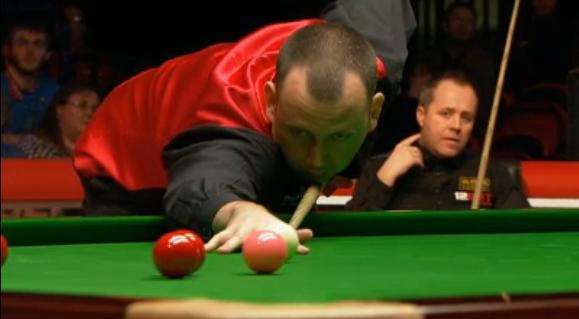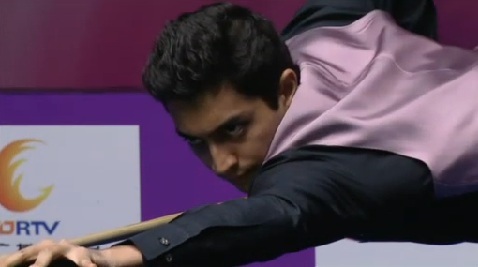A little over three years ago, the UK Championship final was contested between John Higgins and Mark Williams, two of snooker’s ‘golden generation’ in a repeat of the final a decade previously. At the time, I was moved to consider what was a clear trend, of the average age of snooker players at the top of the game increasing compared to previous years.
Last season, we saw the likes of Gerard Greene and Mike Dunn achieve career-best runs in ranking tournaments, while Rod Lawler, Dominic Dale, Alan McManus and Fergal O’Brien all recorded notable achievements now into their forties.
That being the case, I decided to revisit my previous analysis, with the tour having undergone a series of significant changes in recent seasons to see whether the trend has continued…
The Statistics
As I did back in 2011, I have taken the top 64 in the rankings at the end of the 2013/14 season, to compare to my previous figures from 2000 and 2011.
In order to better illustrate not just the quantity of those in each bracket, but their respective performances, I have also colour coded the players, with top 16 players in red, 17-32 players orange and 33-64 ranked players in green.
So to begin, a reminder of how the top 64 looked back in 2000…
Top 64 by age as of February 2000:
| 16-20 (0) |
21-25 (15) |
26-30 (23) |
31-35 (15) |
36-40 (8) |
41-45 (2) |
46-50 (1) |
| – | John Higgins |
Stephen Lee | Stephen Hendry | John Parrott |
Steve Davis |
Joe Johnson |
|
–
|
Mark Williams |
Ken Doherty | Dave Harold | Jimmy White | Gary Wilkinson | – |
|
–
|
Ronnie O’Sullivan |
Alan McManus | Tony Drago | Alain Robidoux | – | – |
|
–
|
Matthew Stevens |
Anthony Hamilton | Nigel Bond | Paul Davies | – | – |
|
–
|
Paul Hunter |
Fergal O’Brien | Darren Morgan | Neal Foulds | – | – |
|
–
|
Graeme Dott |
Peter Ebdon | Billy Snaddon | Peter Lines | – | – |
|
–
|
Quinten Hann |
Mark King | Brian Morgan | Steve James | – | – |
|
–
|
Jamie Burnett |
Chris Small | Joe Perry | Dean Reynolds | – | – |
|
–
|
Marco Fu |
Dominic Dale | Martin Clark | – | – | – |
|
–
|
Lee Walker |
James Wattana | Euan Henderson | – | – | – |
|
–
|
Matt Couch |
Joe Swail | Drew Henry | – | – | – |
|
–
|
David Gray | Terry Murphy | Dave Finbow | – | – | – |
|
–
|
Alfie Burden |
Andy Hicks | David Roe | – | – | – |
|
–
|
Gary Ponting |
Ian McCulloch | Mick Price | – | – | – |
|
–
|
Bradley Jones |
Gerard Greene | Jonathan Birch | – | – | – |
|
–
|
– |
Marcus Campbell | – | – | – | – |
|
–
|
– |
Jason Ferguson | – | – | – | – |
|
–
|
– |
Rod Lawler | – | – | – | – |
|
–
|
– |
Nick Walker | – | – | – | – |
|
–
|
– |
Paul Wykes | – | – | – | – |
|
–
|
– |
Jimmy Michie | – | – | – | – |
|
–
|
– |
Jason Prince | – | – | – | – |
|
–
|
– |
John Read | – | – | – | – |
As is immediately apparently from a quick glance at the three lists, back in 2000 the main tour was significantly younger, with 38 of the world’s top 64 aged 30 or younger.
Not only were there more players in this age bracket, but there were also more higher ranked players, with 12 of the world’s top 16 yet to pass 30, including the likes of John Higgins, Mark Williams and Ronnie O’Sullivan, who of course would remain among the elite for many years to come.

This meant that there were just three players over 40 inside the top 64, something that is unthinkable now (see below), while there were just eight between 36-40, two of whom were ranked inside the top 16.
Top 64 by age as of February 2011:
| 16-20 (2) |
21-25 (8) |
26-30 (9) |
31-35 (17) |
36-40 (19) |
41-45 (7) |
46-50 (1) |
51-55 (1) |
| Anthony McGill | Ding Junhui |
Neil Robertson |
John Higgins |
Peter Ebdon |
Stephen Hendry |
Jimmy White |
Steve Davis |
|
Jack Lisowski
|
Mark Allen |
Mark Selby | Mark Williams |
Mark King |
Ken Doherty | – | – |
|
–
|
Jamie Cope |
Stephen Maguire |
Ronnie O’Sullivan | Stephen Lee |
Nigel Bond | – | – |
|
–
|
Judd Trump |
Shaun Murphy |
Ali Carter |
Mark Davis | Tony Drago | – | – |
|
–
|
Liang Wenbo |
Ricky Walden |
Graeme Dott |
Gerard Greene |
Peter Lines | – | – |
|
–
|
Matt Selt |
Ryan Day |
Marco Fu |
Joe Perry | Dave Harold | – | – |
|
–
|
Jamie Jones |
Martin Gould | Stuart Bingham | Dominic Dale |
Joe Swail | – | – |
|
–
|
Jimmy Robertson |
Tom Ford |
Matthew Stevens |
Marcus Campbell | – | – | – |
|
–
|
– |
Mark Joyce | Andrew Higginson | Rory McLeod |
– | – | – |
|
–
|
– |
– | Barry Hawkins |
Mike Dunn | – | – | – |
|
–
|
– |
– | Robert Milkins | Fergal O’Brien | – | – | – |
|
–
|
– | – | Jamie Burnett |
Anthony Hamilton | – | – | – |
|
–
|
– |
– | Michael Holt | Alan McManus | – | – | – |
|
–
|
– |
– | Alfie Burden |
Barry Pinches | – | – | – |
|
–
|
– |
– | Joe Jogia |
Andy Hicks | – | – | – |
|
–
|
– |
– | Stuart Pettman | Adrian Gunnell | – | – | – |
|
–
|
– |
– | Bjorn Haneveer | Rod Lawler | – | – | – |
|
–
|
– |
– | – | Ian McCulloch | – | – | – |
|
–
|
– |
– | – | Matt Couch | – | – | – |
A decade on, with 19 players inside the top 64 aged 30 or under, remarkably the amount of players in that bracket had halved exactly.
This is primarily accounted for by an increase from 8 to 19 in the 36-40 bracket, while there were also an extra six in the over 40’s section.

In terms of ranking position, there were four fewer top 16 players aged 30 or younger, with a number of players who were there a decade previously such as Higgins and O’Sullivan, retaining their places.
Top 64 by age as of May 2014:
| 16-20 (1) |
21-25 (6) |
26-30 (17) |
31-35 (11) |
36-40 (14) |
41-45 (12) |
46-50 (2) |
51-55 (1) |
| Luca Brecel |
Judd Trump |
Mark Selby |
Neil Robertson |
Ronnie O’Sullivan |
Mark Davis |
Nigel Bond |
Jimmy White |
|
–
|
Xiao Guodong |
Ding Junhui |
Barry Hawkins |
Marco Fu |
Dominic Dale |
Dave Harold | – |
|
–
|
Michael White |
Mark Allen |
Shaun Murphy |
John Higgins |
Peter Ebdon |
– | – |
|
–
|
Jack Lisowski |
Liang Wenbo |
Ricky Walden |
Stuart Bingham |
Alan McManus |
– | – |
|
–
|
Anthony McGill |
Tom Ford |
Ali Carter |
Joe Perry |
Fergal O’Brien |
– | – |
|
–
|
Cao Yupeng |
Kurt Maflin |
Stephen Maguire |
Graeme Dott |
Ken Doherty |
– | – |
|
–
|
– |
Mark Joyce |
Ryan Day |
Mark Williams |
Marcus Campbell |
– | – |
|
–
|
– |
Ben Woollaston |
Michael Holt |
Matthew Stevens |
Rod Lawler | – | – |
|
–
|
– |
Jamie Cope |
Martin Gould |
Robert Milkins |
Anthony Hamilton | – | – |
|
–
|
– |
Matt Selt | David Gilbert |
Mark King |
Rory McLeod | – | – |
|
–
|
– |
Aditya Mehta | Dechawat Poomjaeng |
Andrew Higginson |
Mike Dunn | – | – |
|
–
|
– | Yu Delu | – |
Jamie Burnett |
Peter Lines | – | – |
|
–
|
– |
Jimmy Robertson | – | Gerard Greene |
– | – | – |
|
–
|
– |
Jamie Jones | – |
Alfie Burden |
– | – | – |
|
–
|
– |
Pankaj Advani | – |
– | – | – | – |
|
–
|
– |
Thepchaiya Un-Nooh | – | – | – | – | – |
|
–
|
– |
Robbie Williams | – | – | – | – | – |
So how does the situation compare three years on, with the moves towards a prize money based rankings system and flat draws further altering the snooker landscape?
One of the most startling statistics is that the number of top 16 players aged 30 or under has halved since 2011, meaning that there are now just four, with Mark Selby set to turn 31 in a few weeks time.
This represents a complete turnaround from the position back in 2000, when there were 12 in that bracket and with the exception of Xiao Guodong, there is little sign of the trend being reversed in the short-term at least.
Interestingly however, there has been a notable jump in players aged between 26-30 in the lower half of the rankings during the past three years, the rise of players such as Aditya Mehta, Yu Delu and Robbie Williams amongst others showing that it is possible to make progress.

Perhaps the most notable change compared to back in 2000 however, is that there are now 15 players over 40, compared to 9 in 2011 and just two in 2000. With a further 14 in the tier below, 10 of whom are still ranked inside the top 32, as Alan McManus said recently at the Crucible, there is still clearly a place for the ‘senior’ players at the top of the game.
As discussed during my previous article, there are a number of reasons for the trend, primarily the sheer quality and number of the ‘golden generation’ of players who turned professional together, during snooker’s boom period towards the end of the 1980’s and early 1990’s.
Of course they cannot go on forever, but the likes of Steve Davis and Jimmy White have shown what is possible by remaining on the tour in their fifties and it will be interesting to see 5-10 years from now whether there will be a shift back towards youth, or whether the current trend will continue.

Certainly in the short to medium-term, I generally would expect the current established players to remain at the top of the rankings, as indicated within my recent look at how the top eight might look in 2019.
But as demonstrated above, although the recent changes to the tour and event structures remain in their infancy, the significant increase of players in their mid to late 20’s is perhaps indicative of the increased opportunities to climb the rankings these days and time will tell as to whether these players will be able to push on further and into the top 16, 32 over the next couple of years.
The likes of Xiao Guodong, Aditya Mehta, Kyren Wilson, Robbie Williams and Joel Walker in particular impressed during last season, while the likes of Michael White, Luca Brecel and Jack Lisowski will be hoping to bounce back and put themselves back into contention.
And course course there are a number of promising amateurs in the game at present, Duane Jones, Oliver Brown, Rhys Clark, Eden Sharav and Shane Castle to name just a few, not to mention those in China such as Zhao Xintong, who will be hoping to turn professional and make a name for themselves in the future.
How do you think the tour will look in the future?

